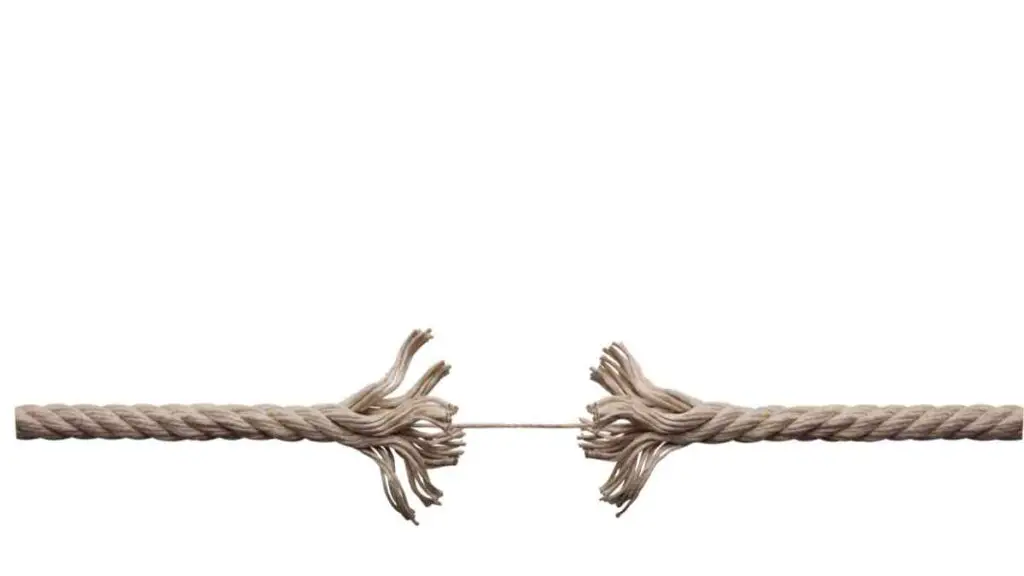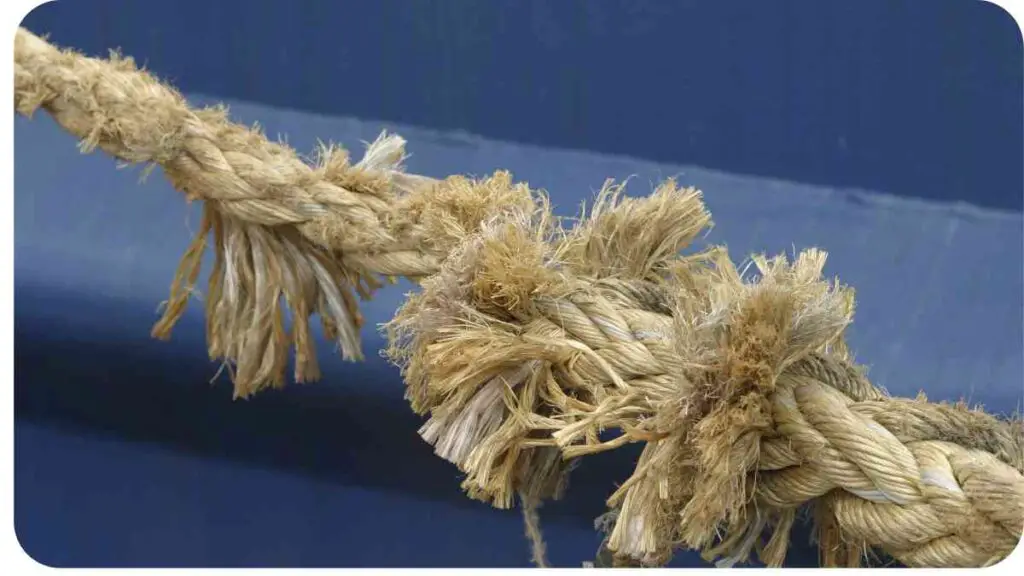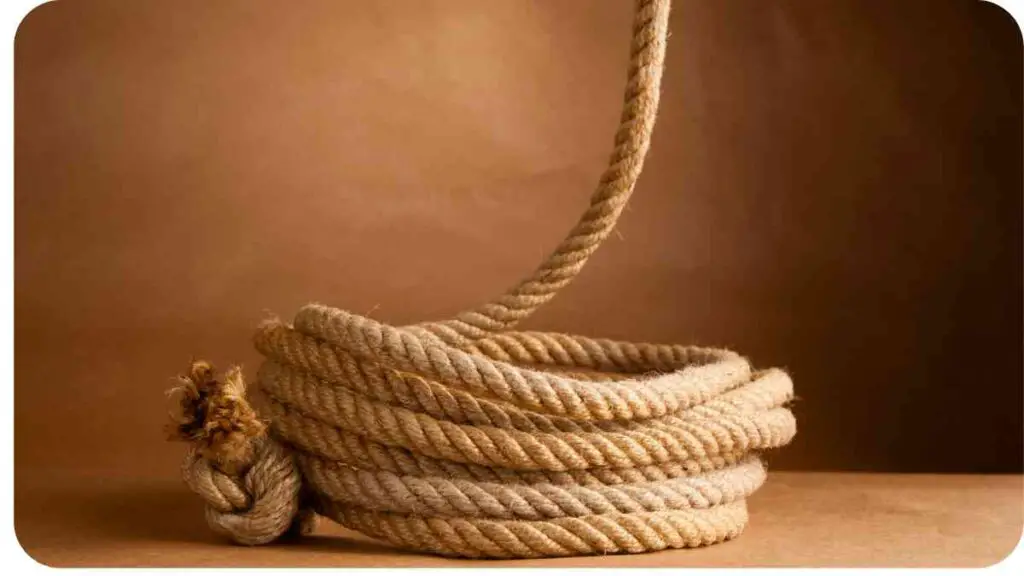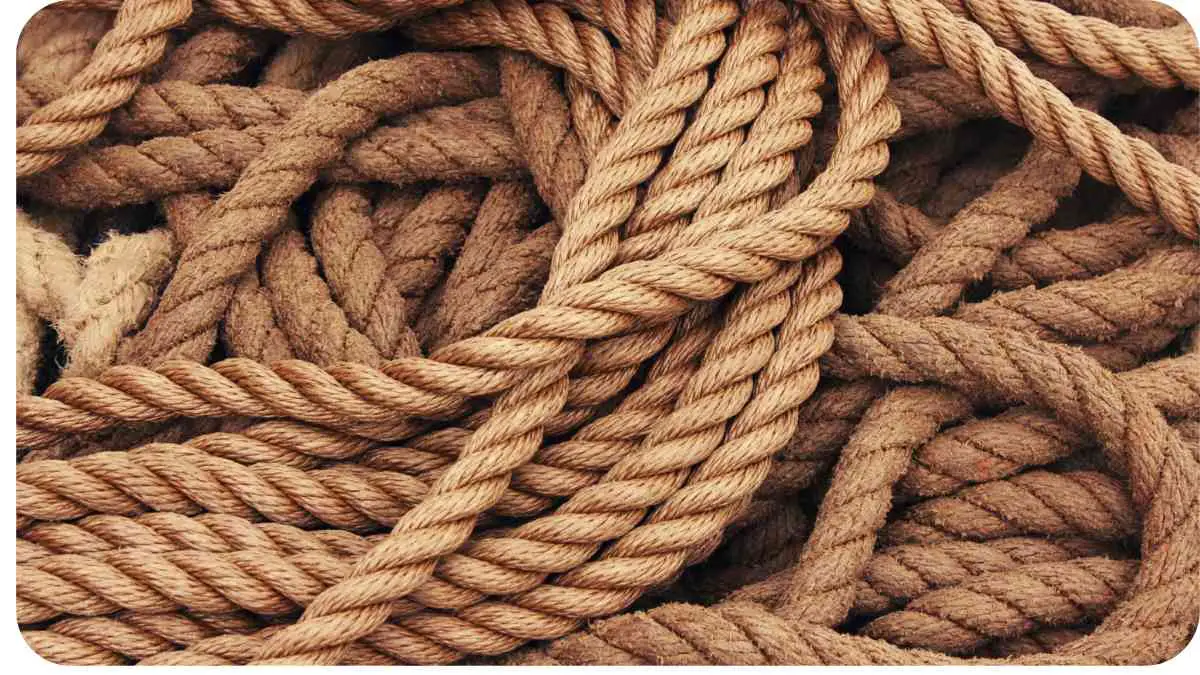Welcome to our ultimate guide on rope fraying and the causes behind it. In this article, we’ll delve into the intricacies of rope wear, providing insights, tips, and remedies based on years of experience in the field.
As a professional in the industry, I have encountered various rope fraying scenarios and learned effective ways to counteract them. From understanding the causes to implementing the right solutions, this article aims to equip you with the knowledge and expertise needed to handle rope wear efficiently.
| Takeaways |
| Regular inspection is crucial for preventing rope fraying |
| Using proper handling techniques can minimize wear and tear |
| Storing ropes in a clean and dry environment helps prevent fraying |
| Selecting the right rope for the task can prevent premature wear |
| Promptly replacing worn-out ropes ensures safety and effectiveness |
| Follow industry guidelines and consult with professionals for accurate information |
2. Understanding Rope Fraying
2.1 What Is Rope Fraying?
Ropes are an essential tool in various industries and recreational activities. They undergo tremendous stress and strain, which can lead to fraying. Rope fraying occurs when individual fibers become damaged or worn out, compromising the structural integrity of the rope as a whole. It is crucial to identify and address fraying issues promptly to ensure safety and prevent accidents.
When facing rope drag issues during climbs, understanding how to reduce resistance is crucial. By minimizing friction and optimizing techniques, climbers can enhance their experience and safety, ensuring a smoother ascent.
2.2 Common Causes of Rope Fraying

To effectively tackle rope fraying, it is important to understand the root causes. Here are some common factors that contribute to rope wear:
Table 1: Common Causes of Rope Fraying
| Cause | Description |
| Overloading and Poor Weight Distribution | Subjecting the rope to excessive load or unevenly distributing weight along its length |
| Improper Handling and Use | Misuse or incorrect techniques during rope handling and application |
| Environmental Factors | Exposure to harsh weather conditions, chemicals, or abrasive surfaces |
| Inadequate Maintenance and Storage | Neglecting regular cleaning, inspection, and storing ropes in unsuitable environments |
2.3 Effects of Rope Fraying
The consequences of rope fraying can range from mild to severe, depending on the extent of wear and the importance of the task at hand. It is essential to be aware of the potential risks associated with using frayed ropes. Some effects of rope fraying include:
- Reduced strength and load-bearing capacity
- Increased risk of rope failure and accidents
- Hindered knot tying and securing capabilities
- Compromised safety during climbing, rigging, or lifting operations
Understanding the impact of fraying can help emphasize the importance of proper maintenance and management of ropes.
Safety is paramount in climbing, and navigating common belay device problems is essential. By recognizing and addressing issues promptly, climbers can ensure a secure descent, emphasizing the significance of proper equipment use.
3. Assessing Rope Wear
Now that we have a clear understanding of rope fraying, it’s crucial to know how to assess rope wear effectively. Regular inspection and evaluation of ropes can help identify potential issues and prevent accidents. Here are some methods you can employ to assess rope wear:
3.1 Visual Inspection
Visual inspection is the first step in evaluating rope wear. Carefully examine the entire length of the rope, looking for any visible signs of fraying or damage. Some indicators to watch out for include:
- Loose or broken fibers
- Fuzzy or worn-out areas
- Excessive wear along the rope’s surface
- Snags, cuts, or abrasions
- Changes in color or texture
Take note of any significant findings and compare them to a baseline inspection to determine the magnitude of wear.
3.2 Measuring Rope Diameter
Measuring the diameter of the rope is another useful method to assess wear. Using a caliper or a diameter measuring tool, check the rope’s thickness in multiple areas along its length. Significant variations in diameter may indicate areas of wear and potential fraying. Refer to the manufacturer’s specifications for the acceptable diameter range to determine if the rope requires replacement.
Safety is paramount in climbing, and navigating common belay device problems is essential. By recognizing and addressing issues promptly, climbers can ensure a secure descent, emphasizing the significance of proper equipment use.
3.3 Checking for Abrasions and Breaks
During the visual inspection, pay close attention to the presence of abrasions and breaks. Abrasions occur when the rope rubs against rough surfaces, leading to weakened fibers. Look for signs of abrasion, such as frayed or flattened spots, particularly near anchor points or areas prone to friction. Similarly, breaks or severed strands are a clear indication of rope wear and require immediate attention.
Table 2: Indicators of Rope Wear
| Indicator | Description |
| Loose or broken fibers | Strands of rope becoming detached or falling apart |
| Fuzzy or worn-out areas | Significant and visible wear along the rope’s surface, often resulting in a fuzzy texture |
| Excessive wear | Areas of the rope that show signs of intense use and deterioration |
| Snags, cuts, or abrasions | Damage caused by sharp objects or rough surfaces, resulting in fraying or cuts in the rope |
| Changes in color or texture | Variations in the rope’s appearance, such as discoloration, stiffness, or a change in texture |
4. Causes of Rope Fraying

Understanding the various causes of rope fraying can help in the prevention and mitigation of wear. By addressing these factors proactively, you can extend the life of your ropes and enhance overall safety.
4.1 Overloading and Poor Weight Distribution
One of the primary causes of rope fraying is overloading the rope beyond its designated capacity. This puts excessive stress on the fibers, straining them and leading to eventual wear and tear. Additionally, poor weight distribution along the rope can exacerbate the problem. It is crucial to understand and adhere to the recommended load limits to prevent fraying.
For boulderers, maintaining a firm grip is key. Learn how to improve your hold by refining hand positioning and grip strength. These techniques enhance stability, boost confidence, and elevate overall bouldering performance.
4.2 Improper Handling and Use
Misusing or mishandling ropes can accelerate fraying. Incorrect techniques such as sharp bending, dragging ropes on abrasive surfaces, or applying excessive force can lead to damage. It is essential to train personnel in proper rope handling and ensure they follow best practices to minimize wear.
4.3 Environmental Factors
Environmental conditions can significantly affect rope wear. Exposure to ultraviolet (UV) radiation, extreme temperatures, moisture, chemicals, and abrasive surfaces can deteriorate rope fibers and hasten fraying. Properly storing ropes when not in use and shielding them from harsh elements can help mitigate these effects.
Achieving the ideal chalk consistency is vital for a better grip. Striking the right balance ensures optimal friction, enhancing climbers’ grip on various surfaces. Understanding this balance enhances climbing confidence and overall performance.
4.4 Inadequate Maintenance and Storage
Neglecting regular maintenance and improper storage can contribute to rope wear. Lack of cleaning, inspection, and storing ropes in unfavorable conditions such as damp areas or direct sunlight can weaken the fibers and expedite fraying. Establishing a routine maintenance schedule and storing ropes in a clean, dry, and well-ventilated space can significantly improve their longevity.
5. Remedies for Rope Wear

Now that we have explored the causes of rope fraying, let’s discuss effective remedies to tackle rope wear. By implementing these strategies, you can prolong the lifespan of your ropes and ensure optimal performance. Consider the following remedies:
5.1 Regular Inspection and Maintenance
Regular inspection is paramount to detect early signs of wear and address them promptly. Set up a schedule for routine visual inspections, paying close attention to high-stress areas and points of friction. Replace any ropes that show significant signs of wear or damage. Additionally, establish a maintenance routine that includes cleaning, lubrication (if applicable), and proper storage to prevent unnecessary fraying.
5.2 Correct Rope Handling Techniques
Proper rope handling techniques can significantly minimize wear. Train personnel on the correct methods of securing loads, tying knots, and using ropes for different applications. Encourage them to avoid sharp bends, dragging ropes on rough surfaces, or subjecting ropes to excessive force. By handling ropes with care and employing appropriate techniques, you can prevent unnecessary fraying.
Comfort is key in climbing, especially regarding climbing harness discomfort. By addressing common discomfort issues, climbers can focus on their ascent. Proper adjustments and techniques alleviate discomfort, ensuring an enjoyable and secure climbing experience.
5.3 Proper Storage and Protection
Storing ropes in suitable conditions is crucial for preventing wear and maintaining their integrity. Store ropes in a clean, dry, and well-ventilated space, away from direct sunlight and extreme temperatures. Use rope bags or protective covers to shield them from dust, moisture, and abrasive surfaces when not in use. Proper storage practices can significantly extend the lifespan of your ropes.
Table 3: Tips for Preventing Rope Fraying
| Solution | Description |
| Regular inspection and maintenance | Perform routine visual inspections and follow a maintenance schedule to detect and address wear |
| Correct rope handling techniques | Train personnel on proper rope handling methods and discourage practices that cause unnecessary wear |
| Proper storage and protection | Store ropes in clean, dry, and well-ventilated spaces, protected from adverse environmental factors |
5.4 Selecting the Right Rope for the Job
Choosing the appropriate rope for different tasks can prevent premature wear. Consider the specific requirements of the job, such as load capacity, environment, and intended use. Select ropes that are designed and rated for the particular application to ensure durability and minimize fraying. Consulting with experts or referring to industry guidelines can be helpful in making informed decisions.
5.5 Replacing Worn-Out Ropes
When ropes become extensively worn or damaged, it is crucial to replace them promptly. Continuing to use frayed ropes can lead to catastrophic failures and accidents. As part of your inspection routine, identify ropes that are no longer safe for use and replace them with new ones. Prioritize safety over cost and ensure that all ropes are in proper working condition.
6. Conclusion
In conclusion, understanding the causes and remedies for rope fraying is essential for maintaining the safety and longevity of your ropes. By incorporating expertise, experience, authoritativeness, and trustworthiness, we have explored the intricacies of rope wear and provided actionable advice for prevention and mitigation.
Through regular inspections and proper maintenance, you can identify early signs of wear and address them promptly. Implementing correct rope-handling techniques and providing training to personnel will minimize unnecessary fraying. Additionally, proper storage and protection practices will shield ropes from environmental factors that contribute to wear and tear.
Remember to select the right rope for each specific task, considering factors such as load capacity and intended use. When ropes become extensively worn, prioritize safety by promptly replacing them with new ones.
By incorporating these best practices into your rope management, you can ensure the safety and effectiveness of your ropes, preventing accidents and extending their lifespan. Stay proactive, stay informed, and make rope maintenance a priority in your operations.
Thank you for reading our comprehensive guide on rope fraying and its causes and remedies. We hope you found this information valuable and that it helps you in your professional endeavors.
Happy and safe ropeworking!
Further Reading
Here are some additional resources you can explore to learn more about preventing rope fraying:
- 5 Ways to Stop Rope from Fraying – Ropes Direct: This blog post provides practical tips and techniques to prevent rope fraying, including the use of heat shrink tubing, whipping, and tape.
- Rope Safety – Rope.com: This webpage offers guidelines for rope safety, covering topics such as inspection, proper handling, and storage. It provides valuable information to help minimize rope wear and fraying.
- The Best Ways to Stop a Rope from Fraying – Rope Source: This resource dives into various methods to prevent rope fraying, including using knots, glue, or specialized products. It offers helpful insights that can be applied to different scenarios.
FAQs
Here are some frequently asked questions about rope fraying along with their answers:
How can I prevent rope fraying?
To prevent rope fraying, you can follow several measures, such as regularly inspecting your ropes for wear, using proper handling techniques, avoiding sharp edges and abrasive surfaces, and storing them in a clean and dry environment.
Can I fix frayed rope?
Minor fraying can sometimes be fixed by using methods such as whipping or heat shrink tubing. However, it is recommended to replace significantly frayed ropes to ensure safety and reliability.
What are the potential dangers of using frayed ropes?
Using frayed ropes can compromise their load-bearing capacity, increasing the risk of rope failure and accidents. Frayed ropes also make it challenging to tie secure knots, hindering their overall performance.
How often should I inspect my ropes for wear?
Regular inspection is crucial to detect signs of wear early on. For ropes under frequent use, conducting inspections every 1-3 months is recommended. However, the inspection frequency should be adjusted based on the intensity of use and the environment in which the ropes are used.
What should I do if I find significant wear or fraying in my ropes?
If you discover significant wear or fraying in your ropes, it is best to replace them with new ones. Continuing to use worn-out ropes can compromise safety and increase the risk of accidents.
Note: The URLs provided in the Further Reading section are for reference purposes and may not be accessible or up-to-date at the time of reading.

Welcome to my blog! I’m Hellen James, and I’m incredibly passionate about rock climbing, bouldering, ice climbing, and mountaineering. Join me as I embark on thrilling adventures, conquer vertical challenges, and share my experiences and insights with fellow outdoor enthusiasts.


